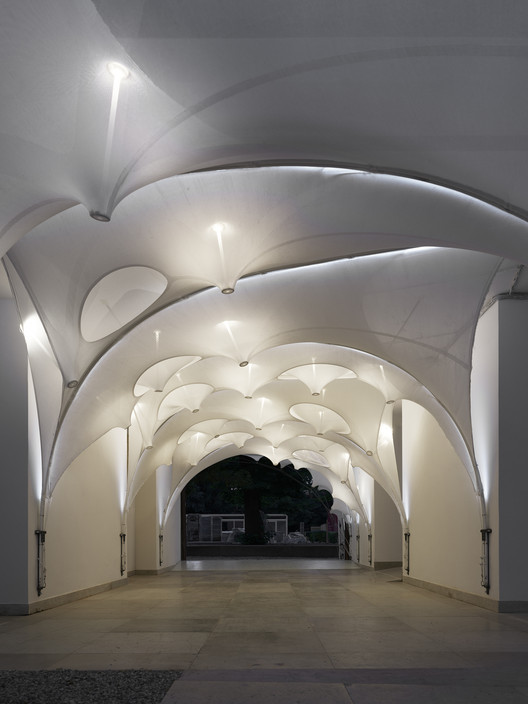
-
Architects: Center for Information Technology and Architecture: Mette Ramsgaard Thomsen, Martin Tamke, Yuliya Sinke Baranovskaya, Vasiliki Fragkia, Rune Noël Meedom Meldgaard Bjørnson-Langen, Sebastian Gatz
- Area: 79 m²
- Year: 2018
-
Photographs:Anders Ingvartsen
-
Manufacturers: Alurays, Dyneema yarn DSM, Glass Fiber rods
-
Engineering: str.ucture, Julian Lienhard, Riccardo La Magna

Text description provided by the architects. Isoropia (greek meaning balance, equilibrium and stability) is a finely tuned balance of tension and compression. Here, bespoke knitted textiles with varying material properties embed active bent fiberglass rods and together they find their equilibrium and form. Isoropia investigates how computational design allows us to rethink material use in architecture. Here the profession comes from a tradition of adding materials to form building elements and buildings, we find, that this practice is highly wasteful. Current techniques and material will not only deplete the resources of our planet, but are as well not able to satisfy the need for housing of the globes growing population. What is needed - are smarter materials, processes and technologies for building. Isoropia advocates a lighter architecture in which material behaviors - the bending, and stretching of materials - are actively employed to build smarter with less.

Collaborative Innovation, new tools for Design Processes
Isoropia is an example of collaborative innovation. It is the product of a broad interdisciplinary collaboration crossing academia and practice. Together we have explored methods for integrating lightweight simulation into architectural design tools. Traditional tools require labor intensive manual prototyping and elaborate structural calculation. Because of this, analysis happens after design and increases costs and time needed in most building projects. However, if early stage design modelling systems can allow an understanding of material behavior it can enable innovative structural and material investigations that radically challenge how architecture is built. This grassroots innovation is community led and open source, creating a free-space for imagining what the material practices of architecture can be.



Multi/performance with a monomaterial
Isoropia examines how to design with interacting behaviors. Structures are rarely mono-material or purely in tension or compression. Instead, they are composed of multiple materials that each hold their own performance. In Isoropia the tensile forces of the bending active fiberglass are counterbalanced by the knitted textile system. Bespoke design of a pattern allows to steer membrane properties By minimizing the textile, thickening the fiber glass rod or tensioning the textile protrusions, the structure changes in expression and form.

Knitted textiles
Isoropia uses knit as a textile membrane on a scale, which was so far not achieved with this traditional technique ever before. Knit is softer and less homogenous than traditional laminated membranes and can be used at the very different scales. By building our own interfaces between the computational design environment and the contemporary digital knitting machines, we are able to control fabrication at stitch by stitch level. The textiles are produced as custom patches and detailing such as the channels, the protrusions and perforations are controlled directly from the design environment. Using the knit allows us to produce to shape and to integrate all construction details within the material itself. With this novel technique, there is no need for any post-processing of the fabricated membranes - they are ready for use, when coming out of the knitting machine. A zero waste production is established on building element scale. As the multifunctional elements are made from only one material, the fibers can be easily reused in existing recycling processes.

New innovative material
Isoropia develops its own material system, in order to steer material behaviour and detailing on building scale. This unique ability is granted through the first time ever use of Dyneema fibres in building scale. Dyneema is the strongest fiber in the world and used in maritime industry for heavy weight lifting or in personal protection gear. It is 15 times stronger and 8 times lighter than the steel wire, non absorbent to water or other liquids and stable against UV-light. In Isoropia the non elastic nature of the fibre provides the necessary baseline strength to create a material, which can adapt and transform to create a tantalizing spatial experience.




























